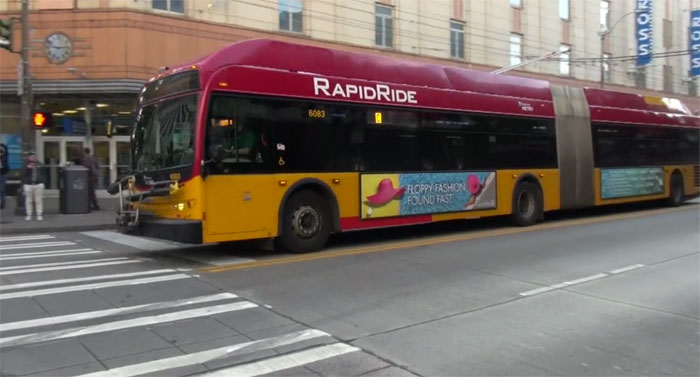Streetsblog once called Seattle City Traffic Engineer Dongho Chang "the coolest traffic engineer in the world."
That was after a team of tactical urbanists calling themselves "Reasonably Polite Seattleites" added plastic pylons to the Cherry Street bike lane in the middle of the night. Rather than retaliate or react defensively, Chang worked with the group to add physical protection to the bike lane.
Chang belongs to a new generation of transportation engineers who see their job as more than moving as many cars as quickly as possible. His work with Seattle DOT has established the city as a national leader on designing multi-modal streets. The results speak for themselves, as transit continues to take mode share away from driving. Nationally, Chang serves on the National Committee on Uniform Traffic Control Devices, which oversees changes to highly influential engineering standards that dictate how American streets are designed.
We got in touch with Chang to discuss his work in Seattle and how the profession is changing. Below is our Q&A, lightly edited for length and clarity.
I notice a lot of street photography on your Twitter. Do you make a point to get out in the field?
For me that’s the most important thing is to see and experience how things are working out in the field. You don’t really understand the dynamic and how the intersection and the street functions until you’re there at very different times.
How do you get around the city?
My primary mode is usually taking my bike during the week. That’s how I normally go around. I do drive. We have wonderful vehicles at work. I can get around various different locations driving.
Sometimes it’s hard to find parking and sometimes it’s hard to get around by driving. Sometimes the most efficient way is to take transit or ride my bike. That’s the best way for me to see the city.
What innovative things are you working on right now in Seattle?
A survey was released that shows only 30 percent [of downtown commuters] are driving alone. In our downtown we’re at capacity. We just don’t have the physical ability to expand for people who are driving alone.
Our strategy is rethinking the best use of the existing lanes in our downtown. Whether that’s transit lanes when we need the capacity, that gives priority and the advantage for those buses. We’re also really thinking about pedestrians -- they need to get off the bus and get were they need to go. So improving the conditions on the street.
We've instituted lower operating speeds for our downtown, wider crosswalks, more time for people to cross, better bike facilities, better predictability. Our Second Avenue bike facility, once we put that in and provided better direction about when drivers go and where cyclists go, collisions for pedestrians were eliminated.

There’s low utilized segments of our street grid. The Pac Man project [above] is an example. We're finding places to build pedestrian spaces in community desired locations.
We are looking at how our traffic control system is working. This is really about looking at a traffic signal that was needed at the time it was put in, but maybe conditions have changed since then. It’s very rare that we take another look.
We tried this at an intersection in the University District. Flashing red worked out really well. Now you go and it’s very much clear. Safety data shows that’s its really working very well. In the 21 months since we changed it, there have been zero collisions. The year before there were two.
We’re asking the community what locations might be good to try this out. The community knows our streets much better. If it doesn’t work out, it’s very easy to change. If it’s not working then all we have to do is remove the stop signs and put [the signals] back on again.
Do you get different instructions from the mayor and city leaders than engineers do in other cities?
I think for the traffic engineering profession there has been very much a goal to move traffic. That’s being dialed back a little bit. Obviously safety is of paramount importance.
We’re a very constrained environment, just because of the geography. It’s very, very tight. There isn’t much room for additional capacity to be built so we’re utilizing it the best we can.







